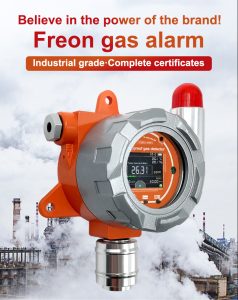-
From Pollutants to Solutions: Harnessing the Potential of Gas Sensors
- Air pollution is a growing concern worldwide, posing significant risks to human health and the environment. To effectively address this issue, it is crucial to understand the composition, sources, and spatial distribution of pollutants in……
- Chat Online
-
Description
Air pollution is a growing concern worldwide, posing significant risks to human health and the environment. To effectively address this issue, it is crucial to understand the composition, sources, and spatial distribution of pollutants in the air. Gas sensors play a vital role in providing real-time, accurate data on air pollutants, enabling us to develop effective strategies for air quality management. This article explores the potential of gas sensors in unveiling air pollution and highlights their importance in monitoring and mitigating this pressing global challenge.

Understanding Gas Sensors:
Gas sensors are devices designed to detect and measure the concentration of specific gases in the air. They employ various technologies like electrochemical, metal oxide, and optical sensing principles to convert the presence of gases into measurable electrical signals. These sensors can detect a wide range of pollutants, including nitrogen dioxide (NO2), sulfur dioxide (SO2), carbon monoxide (CO), ozone (O3), volatile organic compounds (VOCs), and particulate matter (PM).
Real-time Monitoring and Data Collection:
Gas sensors provide real-time monitoring of air quality, enabling prompt response to changing pollutant levels. Unlike traditional air quality monitoring methods that involve sample collection and laboratory analysis, gas sensors offer continuous, on-site measurements. This immediate feedback empowers decision-makers to implement timely interventions, such as adjusting traffic patterns, optimizing industrial processes, or issuing public health advisories. The data collected by gas sensors also helps researchers gain insights into pollutant variations over time and space.
Source Identification and Apportionment:
Gas sensors contribute to identifying the sources of air pollution, which is essential for formulating effective mitigation strategies. Deploying an array of sensors at different locations allows for the analysis of pollutant concentration patterns. By employing advanced statistical techniques like receptor modeling, we can apportion the contributions of different emission sources to overall air pollution levels. This information is vital for targeting specific sectors or activities for pollution control measures.
Indoor Air Quality Monitoring:
In addition to outdoor air quality, gas sensors are valuable tools for monitoring indoor air quality. Since people spend a significant amount of time indoors, poor indoor air quality can have adverse effects on health. Gas sensors can detect indoor pollutants such as formaldehyde, volatile organic compounds (VOCs), and carbon dioxide (CO2). This information enables individuals to take necessary actions, such as improving ventilation, using air purifiers, or choosing low-emission materials, to ensure healthier indoor environments.
Citizen Science Initiatives:
The availability of low-cost gas sensors has facilitated the emergence of citizen science initiatives that actively engage individuals in monitoring air pollution. Citizen scientists can deploy gas sensors in their communities, collect data, and contribute to an extensive network of air quality monitoring stations. This participatory approach not only increases the spatial coverage of air quality monitoring but also raises public awareness of the air pollution issue. The involvement of citizens in data collection fosters a sense of civic responsibility, empowering communities to advocate for cleaner air.
Advancements in Technology and Integration with IoT:
As technology advances, gas sensor capabilities continue to improve, making them more accurate and sensitive. Furthermore, integrating gas sensors into smart city infrastructure, alongside the Internet of Things (IoT), opens up new possibilities for effective air quality management. Gas sensors can be seamlessly connected to IoT platforms, allowing for real-time monitoring and analysis of air quality data. This integration facilitates the implementation of dynamic systems, such as intelligent traffic management, adaptive ventilation systems, and responsive emission control measures.

Policy Implications and Future Outlook:
The potential of gas sensors in addressing air pollution extends beyond monitoring and detection. The data collected by these sensors can inform policymakers and government agencies to develop evidence-based policies and regulations. By leveraging the insights gained from gas sensors, we can create more effective strategies to reduce emissions and improve air quality. Continued advancements in sensor technology, data analysis techniques, and collaboration among stakeholders will further enhance our understanding of air pollution dynamics and lead to innovative solutions.
Conclusion:
Gas sensors play a pivotal role in unravelling the complexities of air pollution by providing real-time, accurate data on pollutant concentrations. They contribute to source identification, indoor air quality monitoring, citizen science initiative
-
Recommend:
-
-
Gas detectors are crucial devices used in various industrie…
-
How do gas detectors ensure industrial safety?
Gas detectors play a crucial role in ensuring the safety of…
-
How Gas Sensors Help Combat Air Pollution?
Air pollution is a pressing global issue that poses signifi…
-
How can gas sensors be used in air quality monitoring?
Air pollution is a significant global concern that affects …
-
 : +86 155 8830 2704
: +86 155 8830 2704 : jxdziot@gmail.com
: jxdziot@gmail.com
